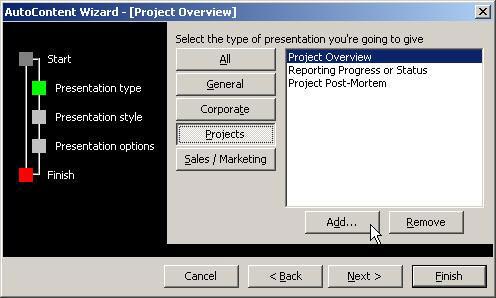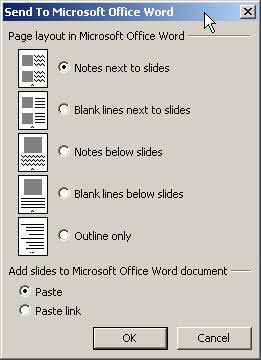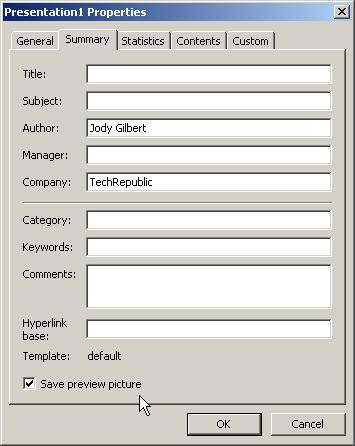10 tips to work more effectively with PowerPoint
PowerPoint is a powerful presentation software, but not all of us often use Powerpoint enough to get the most out of our tips for saving time. Glad you don't need to be an expert to discover all of PowerPoint's features. In this article, TipsMake.com will provide shortcuts and some tips for you to use when working with PowerPoint.
1, Easily change the design pattern (template)
You build a presentation from scratch, but perhaps more appropriate is to use existing templates. These templates apply design attributes and consistent formatting from the first slide to the last slide. Click the Slide Design button on the Formatting toolbar to open the action box for Slide Design and start creating slides. (With PowerPoint 2007, select a template from the Design team).
You are absolutely not tied to the chosen template because after you have completed a presentation file you can choose to replace it with another design. Rest assured to choose the template you want without worrying about changing content.
You can also change the design on each slide without removing the template on the slide show. In the Slide or Slide Sorter View box , select the display type 'thumbnails' for the slide you want to change. Next, click the drop-down arrow next to the desired design in the Apply A Design Template list and select Apply To Selected Slides (Figure A). (PowerPoint 2007 does not have drop-down arrows; right-click the design.) PowerPoint will immediately update the modified slides.

Picture A
2, Focus on the focus
Avoid focusing too much text on a slide. If a slide is too thick, it will certainly distract viewers. Viewers will focus on reading instead of listening to you.
When embarking on creating a draft version of a slideshow, review it for the following purposes:
- Replace the full sentences with the clauses and main keywords
- Avoid unnecessary illustrations
- Remove punctuation
By taking the above steps, you can cut down on half of the content and your presentation will attract more viewers.
3, Don't forget to finish!
At the end of the presentation, what will happen next? If you click outside of Slide Show View, viewers will peek at the scenes behind your show and you probably don't want this. Finish the show with a slide showing a sincere thanks to the viewers' attention and attention.
Of course, the end slide does not necessarily show a certain message. A white slide may be more appropriate. You can even combine two finished slides: Show a brief thanks or a private message on a white slide. In this way, when you click outside the message slide, the document is still hidden securely.
Professional presentations always have a tailor-made final slide. This slide will protect you and your viewers.
4, Create AutoContent templates for yourself
AutoContent Wizard is a good start when you are not sure which slide to choose. This feature creates a new presentation using existing templates and can customize the results.
You may not know what additional slide shows you will add to the AutoContent Wizard library. To do this, follow these steps:
1. Run the wizard by selecting New from the File menu.
2. Click the From AutoContent Wizard link at the New Presentation operation box.
3. Click Next in the first wizard.
4. Select the template type with the most appropriate content and click Add (Figure B).
5. Locate the presentation file and then click OK .
6. Exit the wizard.

Figure B
At this point, the added slide show is ready to use as a content template. Don't waste any good slideshow. Perhaps, you will have to customize it, and this is a common point for any template selected.
AutoContent Wizard is not displayed on PowerPoint 2007. Instead, select File from the Office menu and select New to start.
5, Transfer the slideshow to Word
PowerPoint can be printed but can not modify many results. For example, you can print messages or even individual slides, but PowerPoint only prints one copy on a required slide. If you want to expand or reformat, move the presentation to Word for easier editing. Follow these steps:
1. Select Send To from the File menu.
2. Select Microsoft Office from the child results menu.
3. At the Send To Microsoft Office dialog box (Figure C), select one of the many conversion options. Outline Only option only converts content.
4. Click OK .

Figure C
When the presentation content has been converted to Word, you can apply formatting and printing options that are not displayed on PowerPoint.
In PowerPoint 2007, use the Publish command to transfer content to Word. Select Publish from the Office menu and select Create Handouts In Microsoft Office Word .
When making a newsletter, consider showing it at the end or at the beginning of the performance. People will pay more attention to that newsletter than your presentation.
6, Reverse the headings
You often use heading marks by selecting Slide Design . In particular, choose Fade In One By One from Subtle . The unknown is probably that you can display the heading marks in reverse order. The easiest way to reverse the order of headings is to select Show In Reverse at Moderate in the Animation Scheme box .
You should take the time to review the Animation Scheme options. You will only take a few minutes to get acquainted with all the common effects. In addition, in places related to animation, only use animation when there is a special reason, not just because you like a special presentation.
You'll find animation options on PowerPoint 2007's Animation tab in the Animations group. Use the drop-down list to select the desired effect. The interesting advantage in 2007 is that when you select an effect, PowerPoint displays it, so you can view it before selecting.
7, Notice with GIFs
PowerPoint 2000 is the first version to support the .gif file animation, but the viewer does not (PowerPoint Viewer is an application that supports viewing PowerPoint presentations, even if they do not have PowerPoint installed). Unfortunately, these preview programs do not support .gif files. This restriction may cause errors for your other demos.
The good news is that many applications that view slideshows today support .gif files. These applications fully support the feature from PowerPoint version 97. If you still use an older version of PowerPoint 97, 2000, or XP, viewers will also be able to run slideshows with all files included. both .gif.
8, Reverse the position of the slide pages
Most printers allow reverse printing, but you cannot always set up your own printer options, especially with networked printers and are generally configured for all users. If printing options are limited, you can still print PowerPoint pages in reverse order without adjusting the printer:
1. Select Print from the File menu (For PowerPoint 2007, select Print from the Office menu).
2. Click the Slides option in the Print Range section .
3. Enter the range of the slide in reverse order. For example, if you want to print slides 1 to 10 in reverse order, enter 10-1 instead of 1-10. This is a very easy solution to implement.
PowerPoint will remember this setting until you change it or exit the presentation. Although the printer has a reverse option available, you can easily do it with PowerPoint.
9, Reduce file size
Very large PowerPoint files. If you send them via e-mail, it will take a lot of time to upload or download a slideshow, especially if you or a recipient uses a dial-up connection.
You need to use special software to compress the file before sending them or you can reduce the original file size by deleting the slide thumbnails. Follow these steps:
1. Select Properties from the File menu.
2. Click Summary tab.
3. Locate the Save Preview Picture check box at the bottom of the dialog box (Figure D), uncheck and click OK .

Figure D
Doing this will save a lot of KB, even more than compressing the file. If you disable thumbnails, you will not be able to preview the file in the Open dialog, but this seems to be a small balance to save KB.
This option is difficult to find in PowerPoint 2007. From the Office menu, select Prepare and then Properties, from the Document Properties list drop down, select Advanced Properties to find the Summary tab. You will save space but not much.
10, Control cursor from the keyboard
During the slideshow, PowerPoint hides the cursor 5 seconds after each slide is displayed, and then disappears. When you click to see the next slide, the cursor is visible again in the next 5 seconds. You can control the cursor display by clicking the icon in the left corner of the screen, but this action will distract from the performance. Instead, control the cursor from the keyboard:
- Ctrl + H hides the cursor immediately.
- Ctrl + A displays the cursor immediately.
As soon as you press Ctrl + A to display the cursor, it will be fixed and there is no longer 5 seconds to wait. You must use Ctrl + H if you want to hide the cursor.
You should read it
- How to Hide a Slide in PowerPoint Presentation
- Hide and show slides in PowerPoint
- How to Add a New Slide in PowerPoint
- Instructions to resize Slide pages in PowerPoint
- Design your own slide in PowerPoint
- How to Edit a PowerPoint Master Slide
- How to Add Background Graphics to Powerpoint
- How to create PowerPoint slide frames
May be interested
- How to increase text height on PowerPoint simply and effectively
 powerpoint allows you to adjust the height of text, making the text in your presentation stand out. learn how to change the height and spacing of text effectively with free download.
powerpoint allows you to adjust the height of text, making the text in your presentation stand out. learn how to change the height and spacing of text effectively with free download. - MS PowerPoint: Tips or making rich slide shows
 powerpoint is a program to build the most popular slide shows available today. the following article will guide you to some good tricks in using powerpoint. with powerpoint, you can easily present your ideas through images, texts and sounds. the tips below, hopefully help
powerpoint is a program to build the most popular slide shows available today. the following article will guide you to some good tricks in using powerpoint. with powerpoint, you can easily present your ideas through images, texts and sounds. the tips below, hopefully help - 10 tips in PowerPoint
 here are the 10 most effective tips that are almost an introduction to how to perform functions in powerpoint 2007.
here are the 10 most effective tips that are almost an introduction to how to perform functions in powerpoint 2007. - 7 tips to deal with work stress
 if you are feeling stressed out from your current job, check out some of the tips below to help reduce the pressure on your work.
if you are feeling stressed out from your current job, check out some of the tips below to help reduce the pressure on your work. - 529 computer tips - Work with PowerPoint 2007
 if you create a slideshow from an existing theme and use the styles already in the theme, changing a completely different interface is extremely simple. just select the theme again from the available list on the design tab.
if you create a slideshow from an existing theme and use the styles already in the theme, changing a completely different interface is extremely simple. just select the theme again from the available list on the design tab. - Tips to reduce the size of PowerPoint files should be known
 powerpoint presentations often contain multiple photos, embedded videos, charts, graphs and other content, so it's not surprising that powerpoint files are often large. here are some tips to help you reduce the size of powerpoint files.
powerpoint presentations often contain multiple photos, embedded videos, charts, graphs and other content, so it's not surprising that powerpoint files are often large. here are some tips to help you reduce the size of powerpoint files. - 6 ways to fix the error 'PowerPoint found a problem with the content'
 have you ever encountered the powerpoint found a problem with the content error when opening a .ppt or .pptx file? if restarting your device didn't help, try these tips to get you back to work in no time.
have you ever encountered the powerpoint found a problem with the content error when opening a .ppt or .pptx file? if restarting your device didn't help, try these tips to get you back to work in no time. - Save now how to fix hidden Animations in PowerPoint effectively
 animation in powerpoint is hidden, making it impossible to add motion effects? try the method shared by tipsmake now!
animation in powerpoint is hidden, making it impossible to add motion effects? try the method shared by tipsmake now! - Discover the amazing features of Powerpoint
 in addition to the presentation and editing of slides for office work, powerpoint has many interesting functions that you may not know about.
in addition to the presentation and editing of slides for office work, powerpoint has many interesting functions that you may not know about. - MS PowerPoint 2007 - Lesson 8: Insert tables in PowerPoint
 how to insert a table into powerpoint is as simple as when you perform table insertion on word or create tables in excel.
how to insert a table into powerpoint is as simple as when you perform table insertion on word or create tables in excel.










 Add even and odd page titles in Word 2007
Add even and odd page titles in Word 2007 How to create AutoFill strings in Excel
How to create AutoFill strings in Excel Convert data from Word to Access database
Convert data from Word to Access database Microsoft Office 2008 for Mac
Microsoft Office 2008 for Mac Excel data entry faster
Excel data entry faster Advanced Gmail technology
Advanced Gmail technology